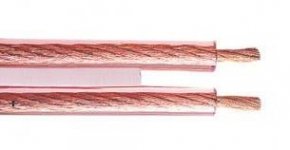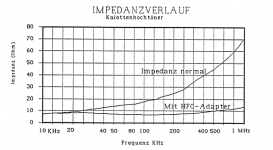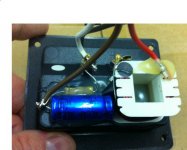PPS..if you believe energy propagation to an 8 ohm load through a 150 ohm twisted pair happens at the conductor prop velocity, I have a bridge to sell you..
I told them so, should we start it up again? 😀
Last edited:
Frank do you think Keith Richards will ever need your special mojo?
I reckon he understood how to get any sort of mojo he needed, or wanted, from way back when ... he knooows ...
And just how do we make a 150 ohm twisted pair at all audio frequencies?Luckily because the system they are building requires very low response times driving a 2 to 5 mH/3 ohm load located about 100 feet from the low impedance power source. The CORRECT application of T-line theory allows them to understand exactly what their system needs in terms of wiring, and what the limitations will be. Using a 150 ohm characteristic impedance wire to drive a 3 ohm load has significant issues at length. .........................
jn
.............................................
PPS..if you believe energy propagation to an 8 ohm load through a 150 ohm twisted pair happens at the conductor prop velocity, I have a bridge to sell you..
......................
OCOS cable maybe?
http://www.6moons.com/audioreviews/ring/ring.html
Last edited:
Gotta love them braindead sound mixers ... 🙄.I might be a grey-hair but I don't run with them. https://www.youtube.com/watch?v=gVsydcqxOAE
One of the reasons I never to go anything live these days - highly likely to get a stewed mess like that ... ain't worth it ...
I do note you have a special fetish for bad language names though, Scott ... hmmmm?
But don't you understand, hifi audio puts Higher Demands on electronics and wires than do these other, mundane applications, and who better to discover these things than the Audiophools, er, audiophiles themselves.I shall try this tonight and report back... though I expect using my monitor calibrator would be a better way to go.
What I do like about quite a few of these 'true believer' mods/effects is they work in all circumstances, like cable lifters, they seem to work on all types of floors and floorings...
But as Fas42 has pointed out, it cant be catered for by normal parameters, don't know how they ever manage to wire up submarines, aircraft, ships, LHCs etc. or how some things could have been missed over the years of research only to be discovered by some lone audiophile guru working tirelessly in his living room...
And like so many of the Great White Rockers, he stole his mojo from a previous musical great.I reckon he understood how to get any sort of mojo he needed, or wanted, from way back when ... he knooows ...
"Stole" ? - every generation "steals" from the previous, and so would have Muddy Waters ... that's how music evolves, and will continue to do so ... music does not emerge from a vaccuum ...
Human hearing puts higher demands on electronics than submarines, etc - which is why most systems struggle to fool anyone that they're listening to a real piano, etc ...
Human hearing puts higher demands on electronics than submarines, etc - which is why most systems struggle to fool anyone that they're listening to a real piano, etc ...
I do note you have a special fetish for bad language names though, Scott ... hmmmm?
Right Frank, whatever.🙄 I'm a "Trainspotting" kind of guy the coarse language does not even make my radar screen.
Last edited:
Every generation tries to "shock" the previous one - but the current one is running out of ideas, badly - we need someone to do something like chopping off a vital "part" or two, just to jazz it up a bit ... 
Edit: the use of "coarse" language to "spice" something up irritates me intensely - it's equivalent to a Benny Hill'ism, or the kid in the old bomb at the traffic lights revvin' it up ...

Edit: the use of "coarse" language to "spice" something up irritates me intensely - it's equivalent to a Benny Hill'ism, or the kid in the old bomb at the traffic lights revvin' it up ...
Last edited:
Every generation tries to "shock" the previous one - but the current one is running out of ideas, badly - we need someone to do something like chopping off a vital "part" or two, just to jazz it up a bit ...
Edit: the use of "coarse" language to "spice" something up irritates me intensely - it's equivalent to a Benny Hill'ism, or the kid in the old bomb at the traffic lights revvin' it up ...
Come on Benny Hill rulez.
😉 https://www.youtube.com/watch?v=SESSGjAwCsY
Your computer speakers turned up to 11 don't qualify?
Last edited:
I'm a Dave Allen man myself, https://www.youtube.com/watch?v=7FweG226aiw ...
Actually, the Aldi TV was/is worse here - flimsy plastic starts rattling at a certain point, not worth going further, 😉 .
Actually, the Aldi TV was/is worse here - flimsy plastic starts rattling at a certain point, not worth going further, 😉 .
I'm quite nervous of stepping back into this thread, given the hostility displayed to new ideas in what is essentially a fun hobby for me. 😱
I think a few people are showing an open mind on some of the physics of cables.
What I took on board from Twisted Pair | Electronics and Electrical Engineering Tools | EEWeb Community was that it is quite hard to get below 50 ohms characteristic impedance with cables. You usually end up near 150 ohms, like with the Cambridge Audio Symphony 400 cable. I think those conductors could be closer.
I suppose exotic methods involve paralleling several cables to get near the 8 ohms of most speakers. Is that Litz Wire?
I quite like the 6 moons audio review of what is essentially Zobel termination of speakers and cables. 6moons audio reviews: OCOS &*Enacom.
I always find that Zobels with bass or tweeter sound smooth. Maybe they work at many levels? 😕
Lastly here's a 47R resistor termination of a tweeter crossover on the metal tweetered first order 3.3uF Mordaunt Short MS10i. Why was it there? Somebody had an idea. 😎
I think a few people are showing an open mind on some of the physics of cables.
What I took on board from Twisted Pair | Electronics and Electrical Engineering Tools | EEWeb Community was that it is quite hard to get below 50 ohms characteristic impedance with cables. You usually end up near 150 ohms, like with the Cambridge Audio Symphony 400 cable. I think those conductors could be closer.
I suppose exotic methods involve paralleling several cables to get near the 8 ohms of most speakers. Is that Litz Wire?
I quite like the 6 moons audio review of what is essentially Zobel termination of speakers and cables. 6moons audio reviews: OCOS &*Enacom.
I always find that Zobels with bass or tweeter sound smooth. Maybe they work at many levels? 😕
Lastly here's a 47R resistor termination of a tweeter crossover on the metal tweetered first order 3.3uF Mordaunt Short MS10i. Why was it there? Somebody had an idea. 😎
Attachments
I'm quite nervous of stepping back into this thread, given the hostility displayed to new ideas in what is essentially a fun hobby for me.
The hostility is to incorrect ideas, whether new or old. The significance of characteristic impedance for speaker cables is incorrect, thoroughly incorrect, no matter how often you repeat it. I am truly puzzled at your stubborn insistence to spread nonsense.
You would probably need superconducting cables to get 8 ohms at audio frequency. You have to get resistance well below inductive reactance from below 20Hz.system7 said:I suppose exotic methods involve paralleling several cables to get near the 8 ohms of most speakers.
How many times do we need to say something before people get it? Not rocket science; you can read about it in any reasonable EM or radio textbook. Not the simple ones, of course, as they just present the RF theory of transmission lines as though it was the whole story - maybe this is where the confusion arises?
How many times do we need to say something before people get it? Not rocket science; you can read about it in any reasonable EM or radio textbook. Not the simple ones, of course, as they just present the RF theory of transmission lines as though it was the whole story - maybe this is where the confusion arises?
You can understand the confusion by looking at the 6Moons link that system 7 posted. If one won't read the basic literature but is eager to lap up the utter nonsense published by audio magazines that are in the business of encouraging ignorance and loosening credit cards, one will believe all sorts of nonsense with a religious fervor. That's system 7's right, of course, ignorance is not a crime, but perhaps websites that do not have a high population of technically competent people might be more "friendly" venues for his silly ideas to be taken seriously and escape criticism.
Human hearing puts higher demands on electronics than submarines, etc - which is why most systems struggle to fool anyone that they're listening to a real piano, etc ...
What a load of s*****
The OCOS review from 6moons reminded me that there is another way to achieve a constant audio characteristic impedance: make the cable insulation conductive. Alternatives would be adding loading inductors (as telephone lines used to do) or (for those who know we only have short cables) adding a shunt resistor at one or both ends of the cable. Interestingly, the first picture (of a sheet headed "OCOS basic research") has a formula for |Z| which is derived from the full transmission line formula. Sadly, knowing |Z| is not enough but maybe they thought people would not be comfortable finding the square root of a complex number? They seem to hint that it took them 10 years to discover what all the decent textbooks say?
As often seems to be the case, HF audio ringing is confused with RF ringing.
That same page also has mention of blanking plates for unused RCA inputs. Possibly useful if you live next to an aeronautical radar site, but not for anyone else.
As often seems to be the case, HF audio ringing is confused with RF ringing.
That same page also has mention of blanking plates for unused RCA inputs. Possibly useful if you live next to an aeronautical radar site, but not for anyone else.
You did? Oh well... ya still my friend??😉I told them so, should we start it up again? 😀
Now, before DF begins to (accurately so) harp on about the lack of R and G in the analysis, remember this: R and G only SLOW the analysis down. They reduce the speed of the end result, NEVER speed it up. The numbers derived from a T-line analysis can only give the FASTEST possible result.. So, any claims that my simplified analysis is horribly wrong is partially true...the truth is even slower.
Energy which travels down a t-line at the prop velocity has a very specific relationship. The inductive energy and the capacitive energy are equal.
darn, no subscripts or superscripts.
EL = EC . Energy inductive equals energy capacitive..
EL = 1/2 LI^2
EC = 1/2 CV^2
1/2 LI^2 = 1/2 CV^2
LI^2 = CV^2
L/C = V^2 / I^2
L/C = (V/I)^2
sqr(L/C) = V/I
Signals which do not have that relationship do NOT travel down the line at prop velocity. For example, the last Q I pointed out, which if examined carefully, shows that the stripline has to essentially fill up by hundreds of transit times.
A parallel pair will run 120 to 150 ohms when one examines the inductance per foot and the capacitance per foot. At audio frequencies, the load determines the final relationship between line voltage and line current. If that relationship is not that of the cable's L/C criteria, then the line cannot propagate that audio signal to the load at prop velocity.
The question I asked on the stripline, how long until the load reached 10 amps?? It was a loaded question. The correct question should be...how long until the load reaches a percentage of the DC value predicted by the load resistance. Because the answer depends on the load to line impedance ratio. The actual question is, how many transits are required to achieve a specific percentage, say 99%. In the example given, that is several hundred transits.
A very good question. A double braid locks out the internal inductances of the conductors, which ends up as 30 nH per foot. 8 ohms requires something on the order of 10 nH per foot. A cylindrical braid does that, flat wide stripline conductors can do that, so can lots of paralleled twisted pairs.And just how do we make a 150 ohm twisted pair at all audio frequencies?
edit: for the specific example of the 100 foot line with a 3 ohm/2 to 5 mH load, the lag in current is in the 50 microsecond realm, however, the current at the amplifier will ALWAYS be exactly one transit time delayed from the load current. So even though there is a 50 uSec lag in load current, the supply is about half a microsecond behind that of the load, making it trivial to measure what is happening at the far end of the cable. Now the problem becomes, how to measure current at that speed without compromise.
Last edited:
- Status
- Not open for further replies.
- Home
- Member Areas
- The Lounge
- Speaker Cable lifters or stands?


